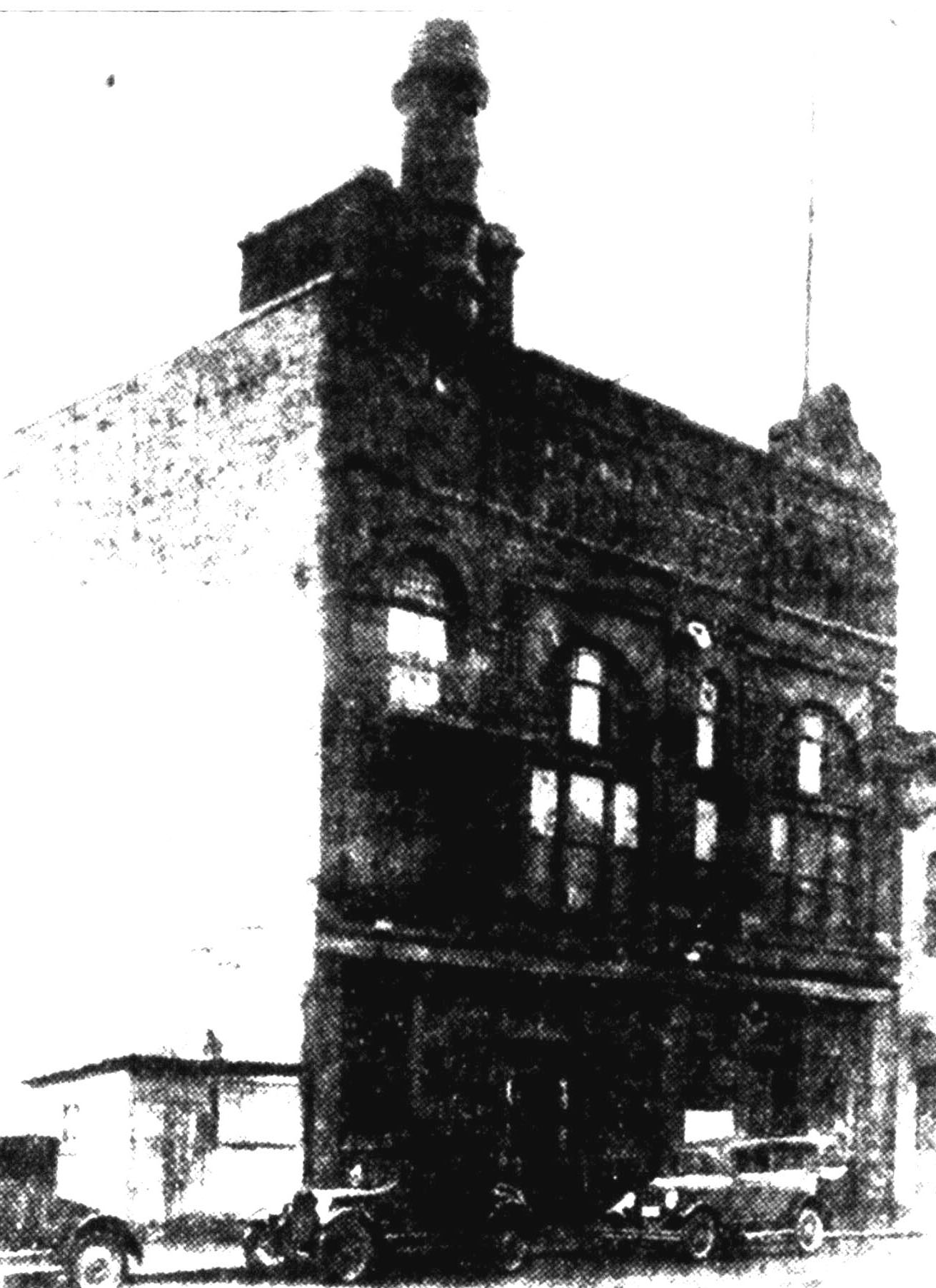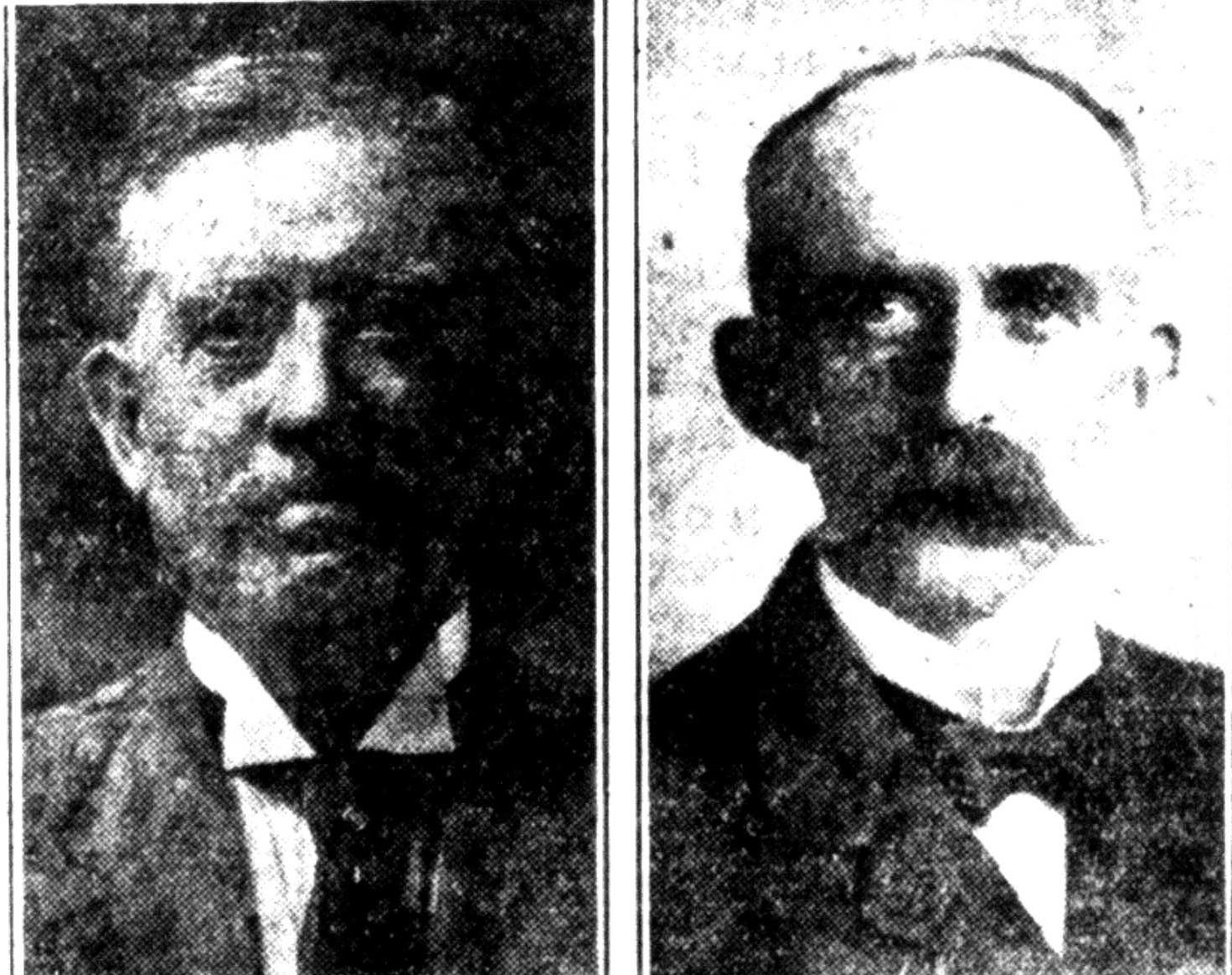

Ancient Order of Hibernians
Ottawa Avenue NW

Left: John Walsh, President of A. O. H.
Right: John H. Sullivan, retired contractor and charter member
|
Ancient Order of Hibernians Old Timers Recall Days When Hibernian Group Was In Its Glory Here St. Patrick's Day and Daniel O'Connell's Birthday Were Festive Occasions Celebrated In Notable Fashion When it was St. Patrick�s day in the morning, there was a general wearing of the green in Grand Rapids for all of the city�s Irish population either was preparing to participate in or applaud the annual parade on the feast of Erin�s patron saint. That was when the Grand Rapids chapter of the Ancient Order of Hibernians was in its heyday and the A. O. H. was the leading body and the center of all activities of Irishmen and sons and daughters of Irishmen here. There would be bands, playing, flying of the Stars and Stripes and the Irish
flag with its harp and emblem, "Erin go Bragh;" Irishmen afoot and Irishmen
proudly mounted on prancing streets would claim the applause of the large crowds
which would line the curbs for the event. Famous Speakers In the evening there would be a musical and speaking entertainment, sometimes with orators of nations: renown on the program in Hibernian hall. For instance, there was Rourke Cochran, the noted Democratic chieftain; Fr. Nugent, the distinguished Grand Rapids Jesuit, who was recognized as one of the most Brilliant speakers in the country, Fr. John W. Cavanaugh, noted scholar and former president of Notre Dame university, and many others of wide reputation to be listened to. Then there was Daniel O�Connell�s birthday, Aug. 6, which the Hibernians here never failed to honor with their annual field day and picnic, usually held at one of the local or Lake Michigan resorts. This always was an occasion for fun-making, athletics and generally, more oratory. For the A. G. H. since 1884,had upheld the tradition of Erin among the local sons of the Ould Sod who had come to Grand Rapids and made this city their home. Thomas Walsh was first president of the organization and again holds that honor, being re-elected last year when it was decided to change the character of the organization�s insurance from fraternal to old line. Many of the early Irish settlers of Grand Rapids still are members of the
organization, which has retained its three-story building on Ottawa ave., north
of Michigan st., throughout the more than four decades. The Grim Reaper has
taken many of the charter and other early members, but to show that sons of
these pioneers are still carrying on, Joseph Fox, past president, is busy
organizing an Irish Athletic club here to have its headquarters in the A. O. H.
hall. Settled Here in 1835 The Irish, it appears, were among our first settlers. As early as 1835 a few of them came here to work on the enlargement of the canal. More continued to come in small numbers, and in 1848, when many Irishmen fled their native land, being under the displeasure of the British government, the arrivals increased. In 1846 Irish relief movement got under way here and liberal contributions of funds were made to alleviate the suffering in Erin resulting from the potato famine, as well as political complications. Great sympathy was shown by the Irish here for their fellow countrymen. Later Fenian troubles and difficulties on account of the exactions of landlords stimulated immigration. John H. Sullivan, now a retired contractor living at 314 Fuller ave. SE., was among the first arrivals from Ireland. He came here in 1854 from County Cork and he well remembers when it was necessary to tie wooden sidewalk where now the Union station stands, to the fence posts to keep it from floating away into the river during high water. All south of Goodrich st. was wilderness then, he recalls, and he can remember when the Indians used to camp near Antoine Campau�s old homestead near what now is Campau park-the square bounded by Antoine and Ryerson sts. And Division and Ionia aves. The MacMunn family he remembers as one of the earliest Irish families here.
One of the boys, Johnny McMunn, lost his life when one of the boats, which then
plied Grand river, blew up. The "Michigan," "Olive Branch," "Grand Rapids,"
"Forest Queen" and "Empire" were some of the boats that were active between here
and Grand Rapids. River Was Big Then "Grand river was real river then." Mr. Sullivan recalls. "I can remember upon one occasion when an Atlantic ocean sailing vessel came up to Grand Rapids when the river was high." The Shields family, one of the members of which Michael Shields was first head of the city fire department: Manus McGurrin, father of Gen, W. T. McGuinn; Henry Hughes, the Courtneys, Caulfields, and Clancys all are remembered by Mr. Sullivan. Mr. Courtney was in charge of the plaster mills, which at that time employed many Irish workers: John Clancy was engaged in the lumber business. Patrick Coade occupied the property on the present side of the Clark building. In those days the section between Division ave. and the river and from the south line of Monroe ave. to Wealthy st.-- beyond which all was woods--was known as "Shasty Town." There was a number of fine residence in this district, including the one owned by Louis Campau, but the humble dwellings of the early Irish working-men and it was from these that the district serived its nickname. George Gray, a great Democratic leader of his day and who later advanced to the rank of colonel in the Civil War, was another well known local Irishman of this time. "The first dime I ever earned was given me by Col. Gray for taking a Republican banner away from another boy in front of the Republican headquarters in old Lane�s hall. Mr. Sullivan relates. Mr. Sullivan boyhood ambition was to be a musician, remarkable that the first
real work was for Jack �Pigeon� Kelly. "I worked two weeks for a violin he owned
and than had to work another week to get it in shape," he said. Railroad Drew Irish In 1875 Mr. Sullivan entered the contracting business, which he continued until his retirement a few years ago. For years he and his family lived on Ionia ave. near old Fourth ave. He is the father of 12 children, 11 of whom are living. "The coming of the Detroit and Milwaukee railroad, now the Grand Trunk, brought many Irishmen here," says Mr. Sullivan. "When I first came here the grading was finished, but it was another year before they laid the tracks. Many of these Irishmen settled in Vergennes, Parnell, Grattan and in that vicinity, clearing the land and putting it in shape to farm." Probably the first Irish priest here was Father Kilroy, assistant at St. Andrew�s when the old stone church was being built at the southeast corner of Monroe ave. and Ottawa st. Rev. Andreas Visziczky, the pastor, a Hungarian, had purchased the site from Richard Godfrey and construction began in 1849. Mention of Fr. Kilroy recalls one of the early tragedies of the city, for the priest�s mother and sister were burned to death in a fire that razed the Godfrey house, used as the rectory, early on the morning of Jan. 14, 1850. Frs. Kilroy and Visziczky and a male servant saved their lives by jumping from a second story window, but Miss Kilroy is said to have lost her life by returning in an attempt to save her aged mother. The fire destroyed all the records of the church, which had been kept for 20 years and was a sever blow to the congregation. Rev. Thomas Brady was the next Irish priest to come here, being rector of St. Andrew�s from 1860 to 1862. Other early Irish priest at St. Andrew�s were Revs. James C. Pulcher, 1868-1872, and Patrick J. McManus, 1872-1883. |
Transcriber: Barb Jones
Created: 27 March 2010